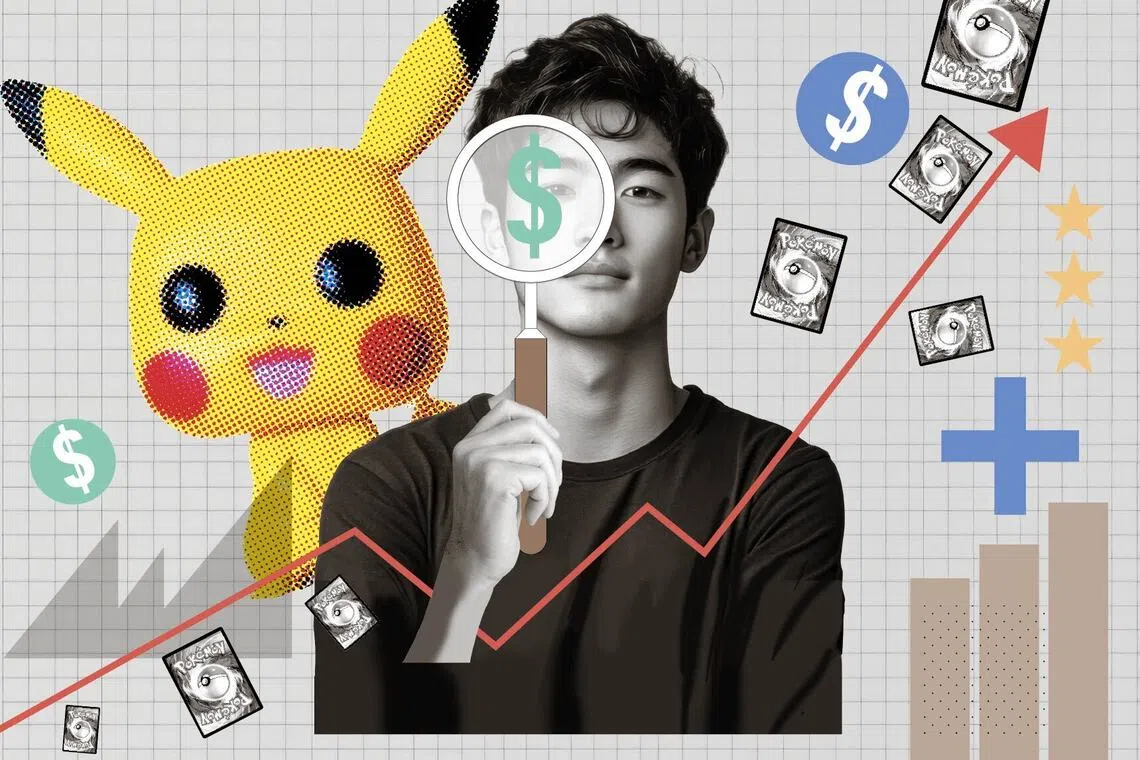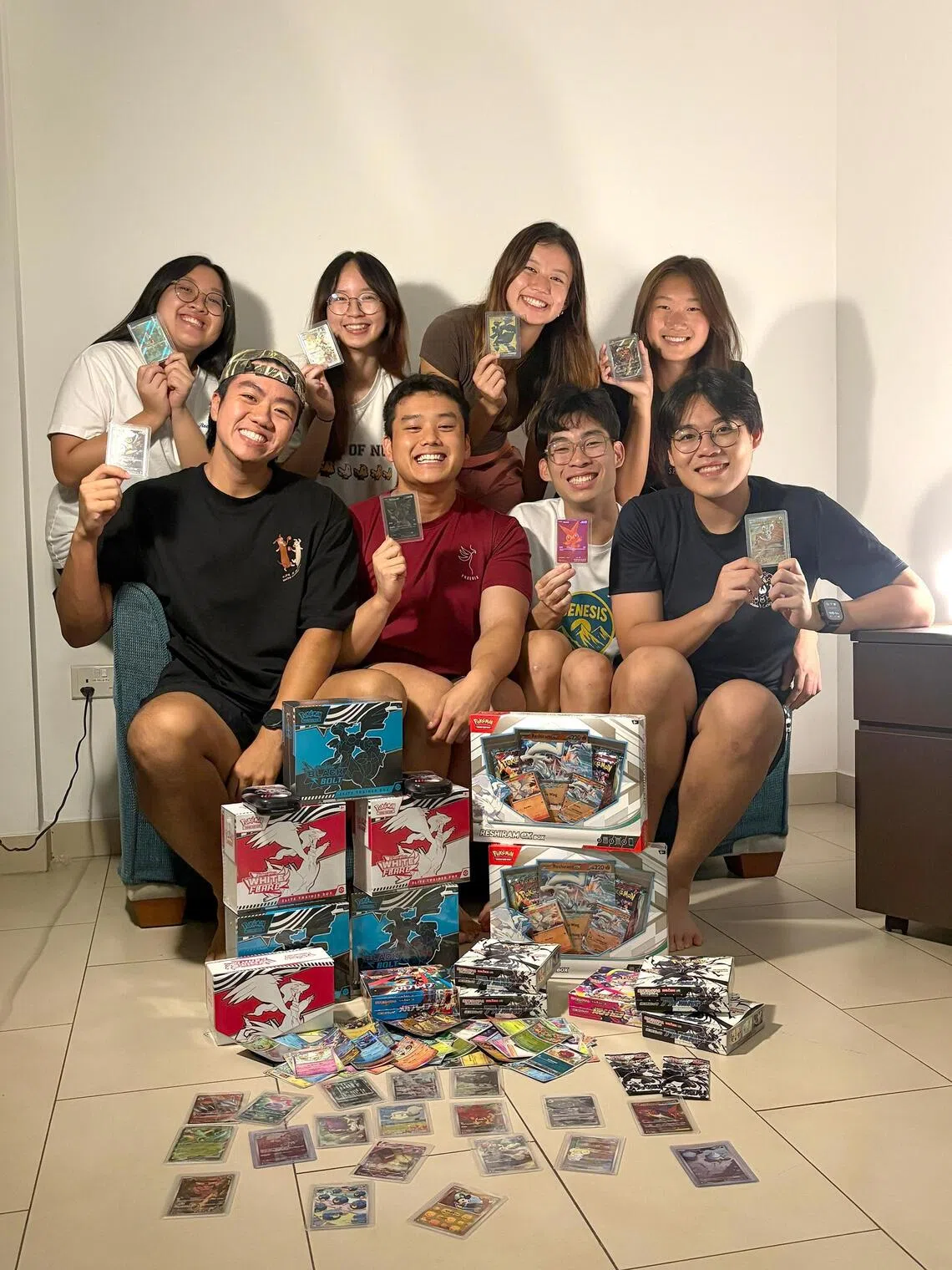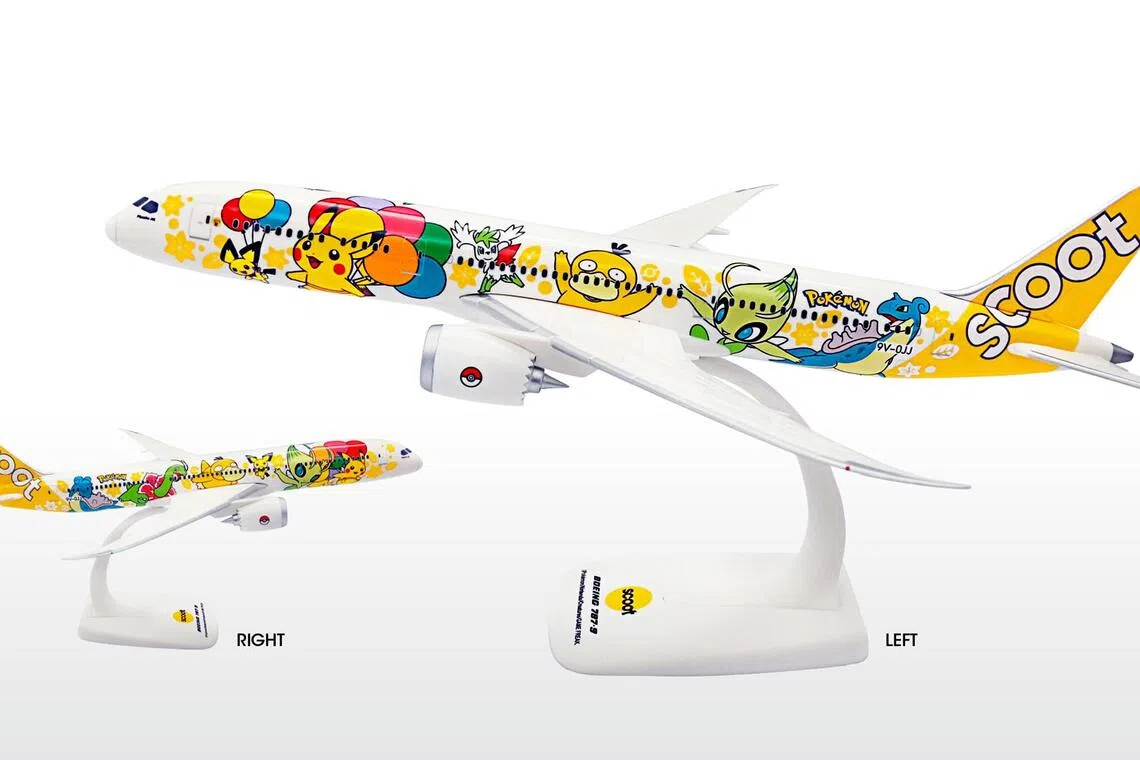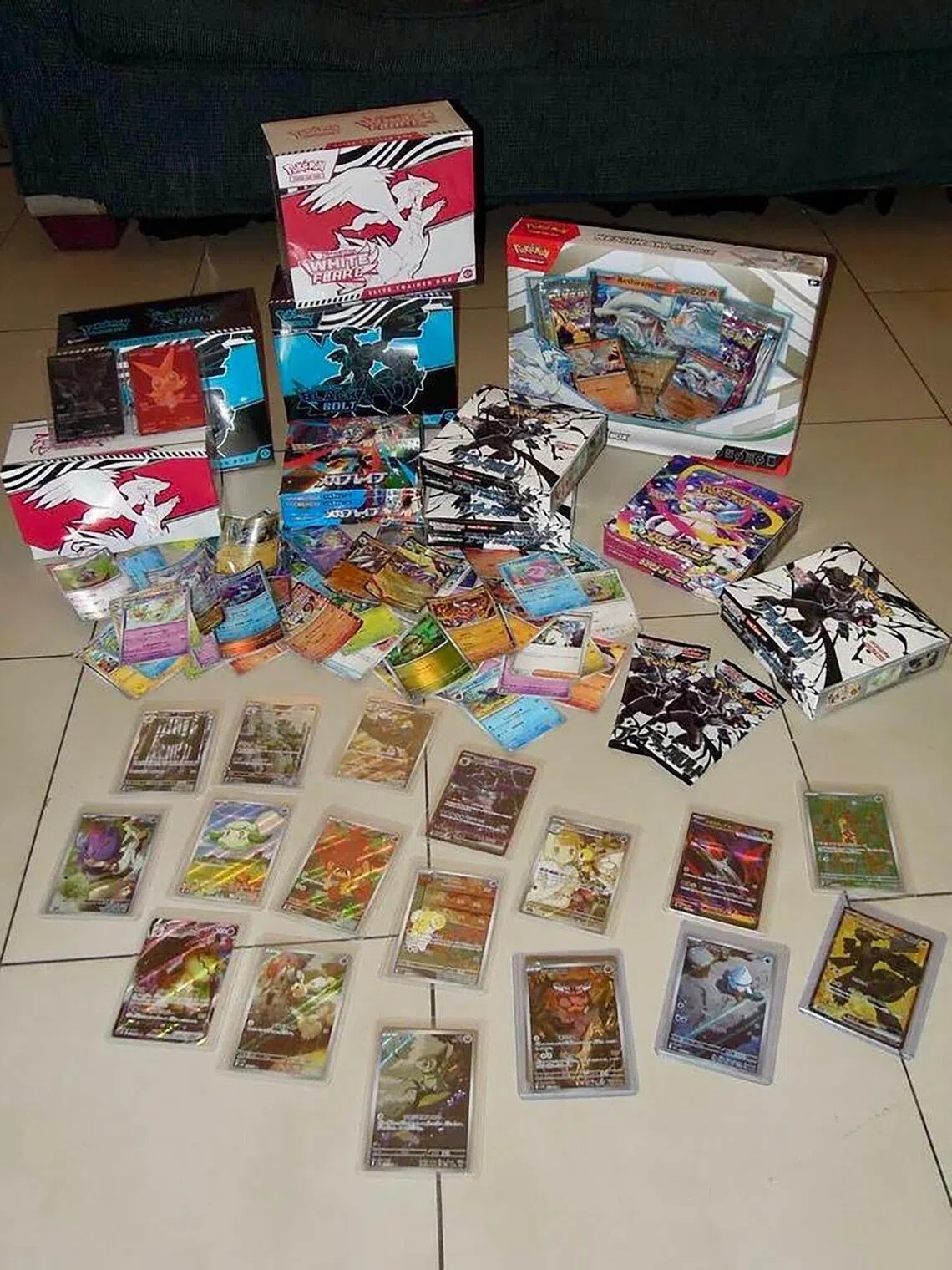In The Money
Go, Pokemon! Rare cards bringing in monstrous value, but are you game enough to invest in them?
Sign up now: Get ST's newsletters delivered to your inbox

Rare Pokemon cards have delivered a staggering 3,821 per cent return since 2004.
ST ILLUSTRATION: CEL GULAPA
Follow topic:
- Pokémon cards have surged as niche investments, offering significant returns driven by nostalgia and limited availability of vintage cards. Rare cards have outperformed the S&P 500 since 2004.
- Celebrities like Justin Bieber and Logan Paul have fuelled the card frenzy, with Paul buying a Pikachu Illustrator card for a record US$5.27 million in 2021.
- Experts warn that IPs need compelling narratives and community support to maintain long-term popularity, noting nostalgia and emotional connection are key, as with Hello Kitty.
AI generated
SINGAPORE - Pokemon cards, once childhood collectibles, have made a comeback as niche investments, notably among young investors chasing returns that exceed traditional equities.
My introduction to the world of these “pocket monsters” – Pokemon is a portmanteau of the words – came one day when my daughter showed me a holographic card protected in a clear sleeve encased in a hard plastic cover.
“What’s that?” I asked as I reached for the item.
“Be careful!” my daughter shrieked. “This is a limited edition PSA-10 Pokemon card.”
Rolling my eyes, I wiped my hands dry as instructed before gently taking the card by its edges to prevent fingerprints and smudges.
“My friend Jeff gave it to me as a present. He said it will be worth a lot more by next year as Pokemon turns 30,” said my daughter.
The incident piqued my interest. Why are smart kids spending their hard-earned money on trading cards?
I did some quick research online and found the value of certain Pokemon cards has risen, mainly due to the nostalgia for vintage trading cards and the competition to get the rare and difficult-to-find ones.
Based on information from the search, it seems that from 1999 to 2003, there was a fixed number of cards printed, and there is a high demand for these cards in mint condition nowadays.

Pokemon devotees (front from left) Zachary Lim, Melden Zel, Joshua Koh and Marko Heng, (back from left) Genevieve Goh, Goh Fay Xien, Renee Tan and Kimberly Kwok with their cards .
PHOTO: RENEE TAN
Rare Pokemon cards have delivered a staggering 3,821 per cent return since 2004, far outpacing the S&P 500 index which gained 483 per cent over the same period, according to data from analytics firm Card Ladder.
In comparison, Nasdaq-listed Meta Platforms, which owns prominent social media platforms including Facebook, Instagram and WhatsApp, has risen 1,855 per cent since its 2012 market debut.
Famous stars have fuelled the Pokemon frenzy, driving the value of the cards higher. Canadian singer Justin Bieber has an insane Pokemon card collection and reportedly paid US$400,000 (S$515,210) for a rare Charizard (orange dragon Pokemon) card in 2019.
But it was American Logan Paul, a former professional wrestling champion, who really sent prices skyrocketing.
The YouTube star with 23.6 million subscribers hit the headlines in 2021 when he bought a rare Professional Sports Authenticator (PSA) 10 graded Pikachu Illustrator card for a record US$5.27 million.
The Illustrator cards are difficult to obtain. They were initially given away as prizes in an illustration contest in Japan. Only 39 copies were distributed, though 41 cards are known to have existed. These cards, which boast artwork by the graphic artist who originally designed Pikachu, Ms Atsuko Nishida, have become the most sought-after “unicorns” in the market.
The Pokemon universe was first conceived by Japanese video-game designer Satoshi Tajiri, who based the game on the idea of collecting bugs, his childhood hobby.
Working alongside illustrator Ken Sugimori, he produced a pair of video games, Pokemon Red and Blue, in which the player must collect all 151 species of pocket monsters – creatures that could be kept in one’s pockets.
These monsters include the yellow mouse-like Pikachu which has the power to create lightning storms, and the blue frog-like Bulbasaur which can go for days without eating.
The games, released on the Nintendo Game Boy in 1996, were a surprise hit that sparked a global wave of Pokemania.
Since then, the franchise has successfully expanded into many other facets of entertainment including movies, TV shows and video games, creating a Pokemon universe. The empire spans everything from plushies and T-shirts to Tiffany necklaces and Baccarat crystal ornaments.
The global phenomenon prompted airlines like Scoot, the low-cost subsidiary of Singapore Airlines, to launch a Pokemon Air Adventures project in 2022, along with its Pikachu Jet designed with Pokemon-related imagery.
Even supermarkets have tried to cash in on the craze. In 2024, FairPrice launched a loyalty programme featuring the “Living with Pokemon Special Edition” collection, where shoppers who fulfil certain conditions get a free Pokemon Trading Card Game Fun Pack.

The global phenomenon prompted airlines like Scoot to launch a Pokemon Air Adventures project in 2022.
PHOTO: SCOOT
The Pokemon franchise, which is celebrating its 30th anniversary in 2026, is estimated to have generated more than US$100 billion in sales, making it the most valuable media franchise in the world, ahead of other icons such as Hello Kitty, Winnie the Pooh, Mickey Mouse and even Star Wars.
From hobby to niche investment
But before you rush out and buy all the Pokemon cards, note that the majority of them are not valuable. Common cards are worth whatever someone is willing to pay, or not pay.
Only specific cards are sought by players and collectors. Even then, the value of such a card depends on its rarity, condition, age and demand for a specific monster’s power and ability to assist in a battle.
Mint condition cards that are authenticated and graded by PSA – the standard for card grading – are worth more than those with minor flaws.

Pokemon cards have seen a cumulative return of more than 3,000 per cent since 2004, according to analytics firm Card Ladder.
PHOTO: RENEE TAN
A first-edition Charizard base set graded PSA gem mint 10 is valued at over US$340,000, compared to less than US$30,000 for a PSA mint 9 one, according to PriceCharting, which tracks the prices of such collectibles.
One colleague bought an ungraded Charizard card for $20, and sold it for $500.
Beginners can go for the starter decks – pre-constructed packages typically contain up to 60 cards, rulebooks, playmats, and sometimes counters or dice.
Many go for the “blind” or booster packs – sealed packages of eight to 15 assorted cards that offer the excitement of potentially getting a mystery or rare card revealed only upon opening.
The more serious collectors buy graded cards. Thanks to third-party certification and population tracking, investors can benchmark prices, compare rarity, and assess historical performance in a transparent way. Leading resources include PSA Card Facts, TCGPlayer and PriceCharting.
My daughter’s friend Jeff started collecting Pokemon cards as a kid when he was a big fan of the franchise.
“Back then, I would only get a few cards a year because my parents didn’t think it was a good way to spend money,” he says, adding: “I started again around 2023 because I started having spare income.”
His collection is now worth $5,000 to $6,000.
Over at the National University of Singapore, a group of young undergraduates took time out from their studies to share their “addiction” with The Straits Times.
They started collecting the cards for fun, with “blind” packs providing the added thrill of not knowing what to expect.
“I started collecting them because they are cute. Now, I collect them as investments too,” says Mr Melden Zel, who has spent hundreds of dollars buying Pokemon cards, and trades them on e-commerce platform Carousell.
Similarly for his friends Renee Tan, Joshua Koh and Goh Fay Xien, the hobby morphed into an investment interest, with the blind packs a “side quest” to finding something new.
While its rise in popularity may seem puzzling, the trend can be partially explained by the lipstIck theory, where consumers turn to small luxuries such as lipstIck – and nowadays, blind boxes – for emotional comfort during an economic downturn, analysts say.
This is seen in China where blind boxes are soaring even as private consumption and economic growth are falling, according to Ms Ivy Ng, Asia Pacific chief investment officer, and Mr Tommy Law, analyst, at German asset manager DWS.
They say successful intellectual properties (IPs) like Pokemon share a common feature – an emotional connection with fans.
Take for example Hello Kitty, which was designed without a mouth so people could project their feelings on her.
Hello Kitty capitalised on the “kawaii” or cute culture in Japan which later expanded globally and became the country’s top IP in the late 1970s.
Similarly, the collectability of Pokemon cards and Labubu – a collectible plush toy monster elf created by Hong Kong toy designer Kasing Lung and sold by Pop Mart in blind boxes – helped transform the two IPs into fashionable trends.
“IPs that resonate emotionally with consumers seem to enjoy strong initial reception, which may contribute to increased merchandise sales and licensing activity,” the DWS experts say.
Is it sustainable?
They warn that the market share of a popular IP could easily be taken by another newer IP that is deemed trendier.
A compelling narrative is often a key factor for IPs to achieve long-term popularity, they say.
IP originators often use graphics including video gaming and animation to develop the characters and create a sophisticated storyline, which help draw and retain fans.
Pokemon’s video games and animations are examples of a series with a well-crafted narrative that contribute to the appeal of its playing cards.
Another example is the Super Mario franchise based on a simple yet engaging storyline of Mario, the loveable hero, rescuing kidnapped Princess Peach from tyrant Bowser – a story that has endured since 1985.
“These IP originators usually generate multilateral revenue streams from the original activities of video gaming and animation production, then monetise the popularity of the IPs to earnings from royalties, merchandise retailing and theme parks,” the DWS experts say.
These additional business activities are efforts to expand the lifecycles of the IPs by maintaining publicity and to diversify revenue streams.
IPs originating in graphic formats, like video games or animation, may be more conducive to developing richer storylines, they say.
Many IPs that achieve long-term popularity often share certain characteristics.
First, nostalgia.
Once the IP has built an emotional connection with consumers that is rooted in childhood memories, it may expand its target audience to grown-ups as fans continue to engage with the IP well into adulthood.
For instance, Hello Kitty has merchandise such as laptop bags which are targeted at adults who could not afford to buy its goods when they were younger. This helps to expand the reach to a broader age group.
Second is a huge fan base and community for IP loyalty and brand education. This is seen in the world of Danish construction toy brick maker Lego, which has an extensive community from the young to adults.
Incidentally, Pokemon and Lego are set to release in 2026 toy bricks featuring the popular media franchise, but they will not be on sale in Lego stores in Singapore, according to a teaser clip shared by Lego and Pokemon on their social media pages.
Robust narratives are critical to anchoring IPs, and prevent them from fading into obscurity as one-hit wonders.
Take Beanie Babies in the 1990s and Be@rbrick in the early 2000s. Both rode waves of celebrity endorsements to rapid popularity.
Similarly, Labubu went viral globally after Lisa from South Korean K-pop girl group Blackpink showed it as a fashion statement.
More luck than anything else
Pokemon cards may have evolved from pop culture to an alternative investment asset, but it pays to note that every few years, a new standout IP may capture the spotlight, leaving your collection in the dust.
Pokemon, like Labubu, may be enjoying the buzz at the moment, but its future depends on whether its creators can transform the fame into an even more lasting legacy that can transcend this generation.
I reckon that except for the rare cards which will appreciate in value, most will remain best kept for personal enjoyment rather than investment.


